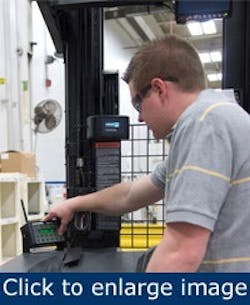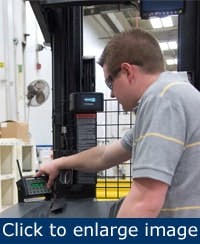Real-time data improves lift truck purchase planning and maintenance management
In a typical five-day, two-shift work week, a lift truck might be in operation for as long as 80 hours. During a full year, that truck will have transported loads for more than 2,000 hours.
If a lift truck is down, even for a few hours, productivity can be lost. Unscheduled downtime is detrimental to meeting throughput requirements. The ability to monitor and maintain lift truck operating statistics is vital to maximizing uptime. Leveraged properly, the data gained from monitoring can help warehouse and distribution center managers run a more efficient, cost-effective operation while increasing productivity.
[pullquote]Bunzl North America (www.bunzldistribution.com), with headquarters in St. Louis, realized quickly the benefits of tracking its lift truck maintenance activities, so as to better manage its lift truck fleets. For Bunzl, the iWarehouse fleet optimization system from Raymond helps the company determine the true cost of ownership of its lift truck fleets at many of its North American facilities; assess when it’s appropriate to service, replace or reassign equipment; and evaluate maintenance trends. At some locations, Bunzl has reduced its maintenance costs by more than 10 percent by utilizing data from the fleet management system.
“We wanted to get better control and understanding of our equipment,” says Rick Castetter, vice president of distribution and warehousing for Bunzl North America. “If we can better plan for maintenance or even reduce and eliminate avoidable maintenance situations, then we’re more cost-efficient and productive.”
Data delivery
Bunzl supplies a range of products, including outsourced food packaging, disposable supplies, and cleaning and safety products to food processors, supermarkets, retailers, convenience stores and other users. The company stocks more than 100,000 SKUs in its North American facilities and ships to customers in the grocery, food service, cleaning and safety, non-food retail and healthcare markets.
At Bunzl’s facilities, operators use Raymond lift trucks, including counterbalanced trucks, for unloading and storing freight, and order-pickers for selecting products. Electric pallet trucks are used for work on the loading dock, but also are carried on trailers to help the company’s delivery drivers quickly and efficiently unload product at customer locations, which puts less stress on the operators’ backs and shoulders than manual handling would.
With so many lift trucks in operation in the United States and Canada and a goal to manage cost and productivity from a corporate level, Bunzl began using the iWarehouse system’s iTrack module in October 2006. It quickly became apparent that the data the system generated, and what it meant, was going to help the company meet its goals for better management and understanding of the lift truck fleets and cost drivers.
“Managers at each distribution center, unless they had their own homegrown spreadsheets for tracking every month, wouldn’t really know how much a unit cost to operate,” says Jeff Earnhart, executive vice president of operations for Bunzl North America. “They couldn’t answer certain questions. ‘How many hours am I using it? What’s my cost per hour? How many times has this been repaired? When was the last time this repair was done?’ It was a manual process. With the fleet optimization system, now that information is really at our fingertips and it helps the managers make smart decisions when they plan to replace equipment.”
Individual lift truck maintenance data is delivered to the distribution center, where it’s accessible via the iTrack module. Earnhart, Castetter and other Bunzl corporate personnel can access that data online for analysis that can maximize lift truck productivity both locally and across the enterprise.
“It’s very helpful for us at a corporate level and at the individual distribution center level to use the data to determine what we need to budget for next year, in terms of capital expenditures,” says Castetter. “Our distribution center managers will access the website and analyze the costs of individual units of equipment and the age of the equipment, to determine whether to keep the equipment for another year or if it’s starting to cost more than it should to keep it running. It’s a huge benefit to be able to identify our cost trends.”
Bunzl also has been able to use the data to determine if a facility has the right number of trucks and the right mix of equipment. The cost analysis helps to determine whether the trucks in a facility are being used efficiently or if any facility has too many or too few trucks to meet throughput requirements.
Data produces cost savings
Earnhart says iTrack provides multiple avenues of cost savings for Bunzl, and nothing is considered too insignificant to be addressed. That’s especially true when it comes to operator training. For example, the system might reveal that a particular lift truck needs to have its brake pads replaced continually, so it could be that its operator isn’t using the brakes correctly, translating to an avoidable cost. It also provides a teaching opportunity for the on-site supervisor.
“If an individual who operates a counterbalanced lift truck suddenly switches to an order-picker, there might be something different about the order-picker that causes the operator to use it incorrectly,” says Earnhart. “The operator might not realize it until the repairs start to build up and a supervisor checks the data. The system gives us access to that kind of information at the corporate level, and for the managers at our distribution centers.”
The system also can help determine replacement component strategies. For example, data might indicate that a facility’s lift trucks require wheel and tire replacements more often than other facilities. That data could prompt a review of key variables, such as the age of the facility and the condition of its floors, and enable the facility manager to balance that information against the cost of replacement parts to determine the best course of action. “If it’s an older building, there could be cracks and uneven areas in the floors that damage tires and wheels,” says Earnhart. “The system allows us to determine the root cause of a problem.”
Because maintaining productivity is crucial for each of Bunzl’s facilities, the company relies heavily on Raymond’s assistance for preventive maintenance and repairs, which are handled regionally by a network of Raymond sales and service centers across the United States and Canada. Technicians at these centers enter data from maintenance and repair work orders into the iWarehouse system’s iTrack module, which is subsequently reviewed and approved by the distribution center manager. From there, approved work orders are consolidated, and Bunzl’s corporate office thus receives a single invoice every other week that combines approved work orders from all 25 facilities networked by iWarehouse, resulting in only 26 invoices annually, instead of multiple separate invoices that used to arrive for each facility. Raymond Sales and Service Center technicians also are adept at helping individual facilities incorporate new technologies.
“We have radio frequency bar coding in our warehouses, so we have radio frequency monitors on our equipment. We’ve worked with Raymond to develop a custom attachment to mount the monitors. Now that attachment is standard for our lift trucks,” says Castetter. “It was valuable to us that Raymond could provide a customized solution to meet our request to accommodate the monitors.”
Growing visibility
Earnhart and Castetter found the ability to organize and review the data on lift truck repairs, costs and work orders has made it easier to make management decisions.
“We might see that the number of hours on a piece of equipment means it’s time to replace it, or maybe we find that we have more equipment in a facility than we need,” says Earnhart. “There’s a lot of information that helps us better manage our equipment and costs, which is really essential to helping us be successful.”

